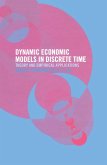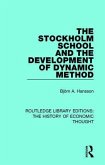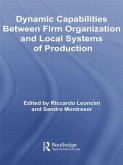Ragnar FrischThe Yale Lectures of Ragnar Frisch
A Dynamic Approach to Economic Theory
The Yale Lectures of Ragnar Frisch
Herausgeber: Bjerkholt, Olav; Qin, Duo
Ragnar FrischThe Yale Lectures of Ragnar Frisch
A Dynamic Approach to Economic Theory
The Yale Lectures of Ragnar Frisch
Herausgeber: Bjerkholt, Olav; Qin, Duo
- Broschiertes Buch
- Merkliste
- Auf die Merkliste
- Bewerten Bewerten
- Teilen
- Produkt teilen
- Produkterinnerung
- Produkterinnerung
This book contains a set of notes prepared by Ragnar Frisch for a lecture series that he delivered at Yale University in 1930., complete with an introdutory essay from Olav Bjerkholt and Duo Qin placing the notes in their historical context.
Andere Kunden interessierten sich auch für
![Fuzzy Approach as a Strong Tool for Solving Economic Issues: The Guide to Fuzzy Theory and Fuzzy Applications on Real Problems Fuzzy Approach as a Strong Tool for Solving Economic Issues: The Guide to Fuzzy Theory and Fuzzy Applications on Real Problems]() Simona HaskováFuzzy Approach as a Strong Tool for Solving Economic Issues: The Guide to Fuzzy Theory and Fuzzy Applications on Real Problems30,99 €
Simona HaskováFuzzy Approach as a Strong Tool for Solving Economic Issues: The Guide to Fuzzy Theory and Fuzzy Applications on Real Problems30,99 €![The Institutional Approach to Labour and Development The Institutional Approach to Labour and Development]() The Institutional Approach to Labour and Development71,99 €
The Institutional Approach to Labour and Development71,99 €![Dynamic Economic Models in Discrete Time Dynamic Economic Models in Discrete Time]() Brian FergusonDynamic Economic Models in Discrete Time59,99 €
Brian FergusonDynamic Economic Models in Discrete Time59,99 €![Confessions of a Wall Street Insider, A Zen approach to making a fortune from the coming global economic crisis Confessions of a Wall Street Insider, A Zen approach to making a fortune from the coming global economic crisis]() Js KimConfessions of a Wall Street Insider, A Zen approach to making a fortune from the coming global economic crisis25,99 €
Js KimConfessions of a Wall Street Insider, A Zen approach to making a fortune from the coming global economic crisis25,99 €![The Indigenous Dynamic in Taiwan's Postwar Development The Indigenous Dynamic in Taiwan's Postwar Development]() Ian SkoggardThe Indigenous Dynamic in Taiwan's Postwar Development60,99 €
Ian SkoggardThe Indigenous Dynamic in Taiwan's Postwar Development60,99 €![The Stockholm School and the Development of Dynamic Method The Stockholm School and the Development of Dynamic Method]() Björn A. HanssonThe Stockholm School and the Development of Dynamic Method35,99 €
Björn A. HanssonThe Stockholm School and the Development of Dynamic Method35,99 €![Dynamic Capabilities Between Firm Organisation and Local Systems of Production Dynamic Capabilities Between Firm Organisation and Local Systems of Production]() Dynamic Capabilities Between Firm Organisation and Local Systems of Production67,99 €
Dynamic Capabilities Between Firm Organisation and Local Systems of Production67,99 €-
-
-
This book contains a set of notes prepared by Ragnar Frisch for a lecture series that he delivered at Yale University in 1930., complete with an introdutory essay from Olav Bjerkholt and Duo Qin placing the notes in their historical context.
Produktdetails
- Produktdetails
- Verlag: Routledge
- Seitenzahl: 208
- Erscheinungstermin: 11. November 2013
- Englisch
- Abmessung: 234mm x 156mm x 11mm
- Gewicht: 324g
- ISBN-13: 9780415746199
- ISBN-10: 0415746191
- Artikelnr.: 39594879
- Herstellerkennzeichnung
- Libri GmbH
- Europaallee 1
- 36244 Bad Hersfeld
- gpsr@libri.de
- Verlag: Routledge
- Seitenzahl: 208
- Erscheinungstermin: 11. November 2013
- Englisch
- Abmessung: 234mm x 156mm x 11mm
- Gewicht: 324g
- ISBN-13: 9780415746199
- ISBN-10: 0415746191
- Artikelnr.: 39594879
- Herstellerkennzeichnung
- Libri GmbH
- Europaallee 1
- 36244 Bad Hersfeld
- gpsr@libri.de
Olav Bjerkholt is Professor of Economics at the University of Oslo. Duo Qin is Senior Lecturer in Economics at Queen Mary, University of London.
I. General Consideration on Statistics and Dynamics in Economics
1. What is economic theory?
2. A discussion of the fundamental distinction between a static and a dynamic economic theory
3. The static and the dynamic conception of an equilibrium
4. Structural
confluent and fictitious relations in economic theory
II. Dynamic Formulation of Some Parts of Economic Theory
5. A dynamic analysis of marginal utility
6. A dynamic formulation of the law of demand
7. A simple case of steered oscillations. The reaction problem
8. A simple case of initiated oscillations
9. Dynamic analysis of a closed economic system
III. Statistical Verification of the Laws of Dynamic Economic Theory
10. Types of clustering in scatter diagrams and the non-significance of partial correlations
11. General principles regarding the possibility of determining structural relations from empirical observations
12. The separation of short-time and long-time components in an empirical time series
13. The phase diagram. Phase elasticities and structural elasticities. The comparison problem in time series components
14. Critical remarks on some of the recent attempts at statistical determination of demand and supply curves
15. A new theory of linear regression. The diagonal and the arithmetic mean regression. The invariance problem
16. A statistical analysis of selected groups of data by the methods developed in the present course
1. What is economic theory?
2. A discussion of the fundamental distinction between a static and a dynamic economic theory
3. The static and the dynamic conception of an equilibrium
4. Structural
confluent and fictitious relations in economic theory
II. Dynamic Formulation of Some Parts of Economic Theory
5. A dynamic analysis of marginal utility
6. A dynamic formulation of the law of demand
7. A simple case of steered oscillations. The reaction problem
8. A simple case of initiated oscillations
9. Dynamic analysis of a closed economic system
III. Statistical Verification of the Laws of Dynamic Economic Theory
10. Types of clustering in scatter diagrams and the non-significance of partial correlations
11. General principles regarding the possibility of determining structural relations from empirical observations
12. The separation of short-time and long-time components in an empirical time series
13. The phase diagram. Phase elasticities and structural elasticities. The comparison problem in time series components
14. Critical remarks on some of the recent attempts at statistical determination of demand and supply curves
15. A new theory of linear regression. The diagonal and the arithmetic mean regression. The invariance problem
16. A statistical analysis of selected groups of data by the methods developed in the present course
I. General Consideration on Statistics and Dynamics in Economics
1. What is economic theory?
2. A discussion of the fundamental distinction between a static and a dynamic economic theory
3. The static and the dynamic conception of an equilibrium
4. Structural
confluent and fictitious relations in economic theory
II. Dynamic Formulation of Some Parts of Economic Theory
5. A dynamic analysis of marginal utility
6. A dynamic formulation of the law of demand
7. A simple case of steered oscillations. The reaction problem
8. A simple case of initiated oscillations
9. Dynamic analysis of a closed economic system
III. Statistical Verification of the Laws of Dynamic Economic Theory
10. Types of clustering in scatter diagrams and the non-significance of partial correlations
11. General principles regarding the possibility of determining structural relations from empirical observations
12. The separation of short-time and long-time components in an empirical time series
13. The phase diagram. Phase elasticities and structural elasticities. The comparison problem in time series components
14. Critical remarks on some of the recent attempts at statistical determination of demand and supply curves
15. A new theory of linear regression. The diagonal and the arithmetic mean regression. The invariance problem
16. A statistical analysis of selected groups of data by the methods developed in the present course
1. What is economic theory?
2. A discussion of the fundamental distinction between a static and a dynamic economic theory
3. The static and the dynamic conception of an equilibrium
4. Structural
confluent and fictitious relations in economic theory
II. Dynamic Formulation of Some Parts of Economic Theory
5. A dynamic analysis of marginal utility
6. A dynamic formulation of the law of demand
7. A simple case of steered oscillations. The reaction problem
8. A simple case of initiated oscillations
9. Dynamic analysis of a closed economic system
III. Statistical Verification of the Laws of Dynamic Economic Theory
10. Types of clustering in scatter diagrams and the non-significance of partial correlations
11. General principles regarding the possibility of determining structural relations from empirical observations
12. The separation of short-time and long-time components in an empirical time series
13. The phase diagram. Phase elasticities and structural elasticities. The comparison problem in time series components
14. Critical remarks on some of the recent attempts at statistical determination of demand and supply curves
15. A new theory of linear regression. The diagonal and the arithmetic mean regression. The invariance problem
16. A statistical analysis of selected groups of data by the methods developed in the present course









